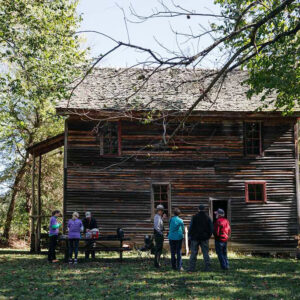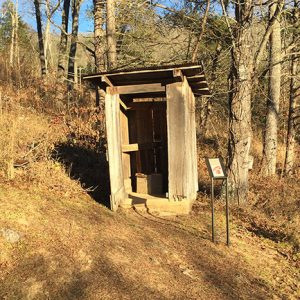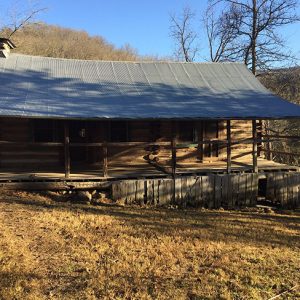calsfoundation@cals.org
Big Buffalo Valley Historic District
aka: Boxley Valley Historic District
Located in Newton County near Ponca (Newton County), the Big Buffalo Valley Historic District (also known as the Boxley Valley Historic District) includes a number of historic structures dating between 1879 and 1930. Also included in the district are a number of archeological sites representing prehistoric peoples. The sites in the district are scattered across the entire valley, which measures more than 8,000 acres. The district was added to the National Register of Historic Places on July 29, 1987, with the original application amended on November 7, 1990.
When created in 1987, the district included about 250 structures. Of the fifty residential structures in the district, only about twenty were occupied at that time. Structures included in the district fall into five categories related to their age and significance. Many are clustered as part of small family farms. Buildings located at the same farm fall into different categories based on age and condition. At the time of the nomination, forty-two of the structures were deemed to be category one, possessing architectural/historical integrity and making a significant contribution.
A total of 160 buildings fell into the second and third categories, including structures built more than fifty years before the nomination and fifty years after. Only thirty-nine structures—built in the twenty to thirty years before the nomination—fell into the fourth category. The final category was for structures that detracted from the district, and few areas fell into that category, mainly updated bridges and picnic areas constructed by the National Park Service for visitors. This also includes modern homes, including mobile homes.
Architectural styles in the valley evolved over the decades, with the earliest homes constructed as single-room cabins. As families grew, these grew into two-room dogtrot houses. The second generation of homes were typically of frame construction with partial or full-length porches and two front entrances. Additions to these homes gave the structures ells or T-shaped layouts. While the earliest settlers in the area utilized stone chimneys, these were replaced by metal flues by this second generation of homes. Included in this generation of structures is the Walnut Grove Church and School, also known as the Boxley Community Building. Constructed in the late nineteenth century, the white two-story wooden building is a notable community gathering spot.
Several commercial buildings are included in the district, including a watermill and the Casey Sawmill, both constructed in the late nineteenth century. Several stores, including the Casey Store, Edgmon Store, and Villines Store are located in the district, as is an early twentieth-century motel constructed by Clyde Villines. Also included in the district is Villines Mill. Constructed around 1840, it is separately listed on the National Register.
The Boxley Valley Historic District includes an interpretive area operated by the National Park Service located at the intersection of Arkansas Highways 43 and 74 near Ponca. The area includes several buildings constructed by the Villines family and by later owners of the property, including an outhouse constructed by the Works Progress Administration (WPA).
The original nomination was amended in 1990 with the addition of forty-two prehistoric archeological sites within the boundaries of the district. The sites date from 6000 BC to the early twentieth century and include sites utilized by Archaic, Woodland, and Mississippian peoples, as well as early settlers in the area. Prehistoric sites include bluff shelters and caves, camping sites near springs, open fields and terraces, and tool workshops. The prehistoric sites include several that contain evidence of habitation stretching from the Archaic period to the early twentieth century. Artifacts recovered at the prehistoric sites include potsherds, flakes, points, scrapers, and drills, while artifacts at the historic sites include iron rims, square nails, and glass.
For additional information:
“Big Buffalo Valley Historic District.” National Register of Historic Places nomination form. On file at Arkansas Historic Preservation Program, Little Rock, Arkansas. Online at http://www.arkansaspreservation.com/National-Register-Listings/PDF/NW0068.nr.pdf (accessed October 6, 2020).
“Big Buffalo Valley Historic District.” National Register of Historic Places nomination form, amended. National Park Service. https://npgallery.nps.gov/NRHP/GetAsset/NRHP/87000110_text. (accessed October 6, 2020).
Liles, Jim. “The Boxley Valley of Buffalo National River: A U.S. National Park Service Historic District in Private Hands.” George Wright Forum 7.3 (1991): 2–5.
Webb, Melody. “Cultural Landscapes in the National Park Service.” Public Historian 9, no. 2 (1987): 77–89.
David Sesser
Henderson State University
 Historic Preservation
Historic Preservation Post-Reconstruction through the Gilded Age, 1875 through 1900
Post-Reconstruction through the Gilded Age, 1875 through 1900 Boxley Grist Mill
Boxley Grist Mill  Outhouse in Big Buffalo Valley Historic District
Outhouse in Big Buffalo Valley Historic District  Villines Homestead
Villines Homestead 




Comments
No comments on this entry yet.